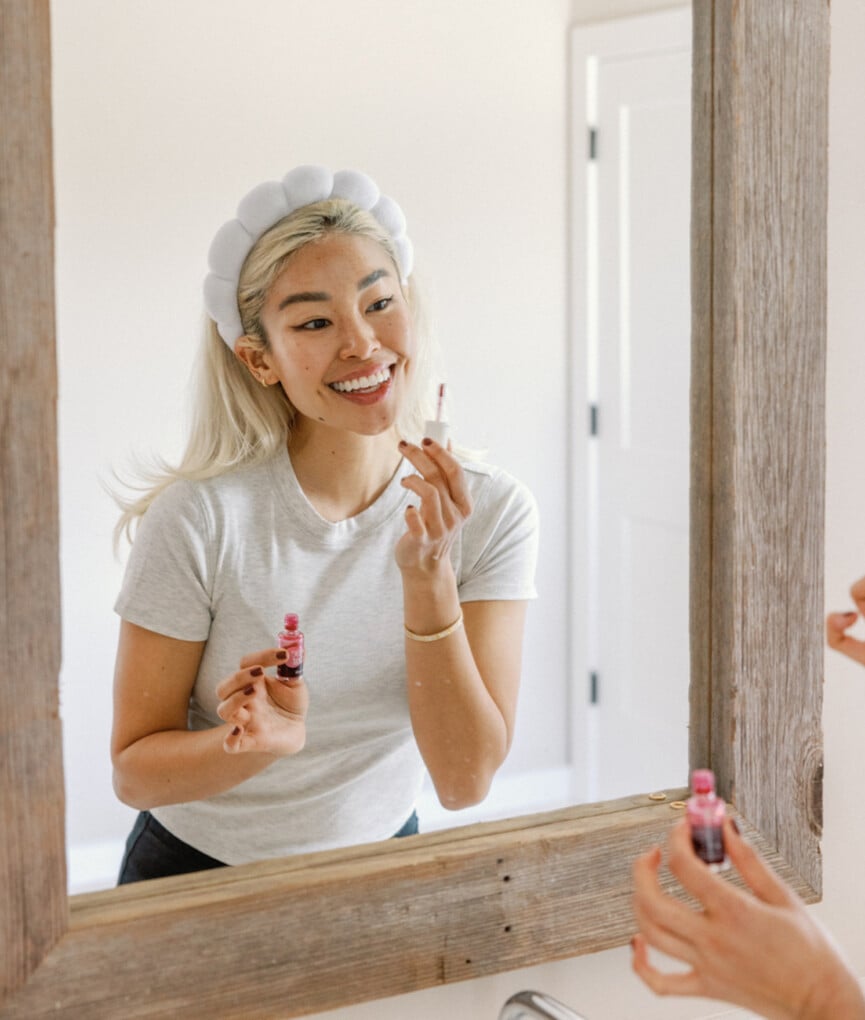10 Wellness Practices You’re Probably Overlooking (but Shouldn’t!)
Your transformation is calling. The post 10 Wellness Practices You’re Probably Overlooking (but Shouldn’t!) appeared first on Camille Styles.

You already know the heavy hitters: clocking 7-9 hours of sleep, drinking filtered water, eating your greens, and staying active. These are the foundational wellness practices. When done consistently, they do the trick. But what if you’re ready to take things one step further? Beyond the basics, there’s a world of lesser-known wellness secrets that work. From listening to binaural beats to auditing your time scrolling social media, these powerful habits will elevate your life. Ready to feel more balanced, energized, and in sync with your body? We’re diving into 10 underrated ways to unlock your peak self.
Featured image by Michelle Nash.

Why should you prioritize foundational wellness habits?
They form the bedrock of our overall health. Basic wellness practices—eating a nutrient-dense diet, managing stress, fostering supportive friendships, spending time in nature, etc.—are the key to a thriving body and mind. They reinforce everything from stable energy levels to balanced hormones. By sticking to these healthy habits, you’re creating a strong base for well-being. Once you have that strong base (read: you nail the basics), it’s time to hit the upgrade button. Enriching your life with bonus wellness rituals is equal parts fun and fulfilling.

Evaluating Your Current Habits
Before you add underrated wellness practices to your routine, tap the breaks. First assess your current habits. You’ll pinpoint areas for improvement—be it sleep, mood, energy, and more. Once you’ve mastered the basics in those areas, you’re primed to explore less conventional habits. But to (effectively!) expand your wellness toolkit, you need to do two things: pay attention to your body’s feedback and remain open to new approaches.
How to Identify the Wellness Practices Your Body Needs
Speaking of tuning into your body’s feedback, it’s a skill many of us struggle with. I’ve coached women for almost 10 years, and one common thread is our tendency to ignore our body’s signals in favor of productivity (and an ego boost). But tuning in is how you’ll discover the wellness practices your body needs. To begin this process, follow these steps:
Monitor your energy levels. Notice if you’re consistently tired. Low energy might indicate a need for better sleep or nutrition. Observe your mood. Track your emotional state. Persistent stress or irritability could suggest a need for stress management practices, journaling, or hormone balance. Evaluate physical symptoms. Pay attention to recurring issues (digestive discomfort or muscle tension). These can signal areas where dietary changes or physical activity might help. Assess overall well-being. Reflect on your general sense of balance and satisfaction in your life. Do you feel imbalanced? Where? This may indicate the need to incorporate new wellness habits.By paying close attention to these cues, you can tailor your wellness practices to better suit your individual needs.
The Power of Integrating New Habits
If there’s anything constant in life, it’s change. Our needs and priorities are ever-evolving. As we grow and shift, so do the things that make us feel our best. What works for us at one stage might need tweaking in the future. This is normal! By remaining curious—and embracing novel wellness practices—we can continue to support our well-being (in the most effective way possible). This ongoing evolution reflects our resilience and our commitment to living with balance and purpose.

10 Underrated Wellness Practices
In no particular order, here are 10 under-the-radar—but still practical!—wellness practices. Each habit offers unique benefits, so take what resonates the most and leave the rest. You do you.
1. Give Your Meals a Nutritious Boost
When it comes to your meals, work smarter—not harder. As a Nutrition Consultant, these are my go-to ingredients to get the most bang for your nutrition buck.
Coconut oil: Upgrade your sautéing, baking, and roasting to coconut oil. It’s rich in healthy monounsaturated fats, antioxidants, and has a high cooking temp (unlike olive oil). Ancestral blends: If you’re squeamish about the thought of eating organ meats, try an ancestral blend (combines traditional cuts of meat with organ meats—like liver and heart) from brands like Force of Nature. These blends are a nutrient-dense source of vitamins and can support energy levels, improve immune function, and promote overall health. Fermented foods: Ingredients like sauerkraut and kimchi do wonders for gut health. Enjoy alongside any savory dish! Sardines: Don’t forget tinned fish. Sub your canned tuna for a more sustainable and heart-healthy option like sardines. They’re rich in calcium and omega-3s to support brain health. Hemp seeds: Keep a shaker of hulled hemp seeds on your table to sprinkle on salads, soups, or oats. You’ll get a boost of plant-based protein and omega-3s. Ground flaxseeds: Add a tablespoon of ground flaxseeds to homemade yogurt, smoothies, or baked goods to increase your intake of healthy fats and fiber. Microgreens: Throw a handful of fresh microgreens (or broccoli sprouts) into your grain bowls, smoothies, or pasta dishes for a slew of micronutrients. Turmeric: Add a dash of ground turmeric to your eggs or baked chicken for its powerful anti-inflammatory properties.
2. Start Savory, Not Sweet
Kickstart your day with a savory breakfast (rather than reach for a bowl of refined carbs). Focusing on meals that include protein and healthy fats—i.e., sheet pan harvest hash, a veggie-loaded omelet, or a bowl of cottage cheese topped with smoked salmon—helps regulate blood sugar levels and prolongs satiety.
This approach minimizes the energy crashes that sugary breakfasts often cause. By prioritizing nutrient-dense, savory options, you’re keeping hunger at bay and setting a balanced foundation for the rest of your meals. This practice is remarkably helpful for balancing hormones, too!
Take a closer look at your social media habits. One of my favorite wellness practices, it can be a game-changer for your self-confidence and productivity (duh!). By unfollowing accounts that trigger negative emotions/contribute to unnecessary stress, you create a more positive digital environment for yourself.
This practice reduces comparison and anxiety, fostering a healthier self-image. Additionally, take inventory of how much time you spend scrolling. Along with cleaning up your feed, I recommend getting a pulse on your scroll time at the end of every month. Before you know it, you’ll free up more time for real-life activities and connections.

4. Lift Heavy (or Heavier)
Often overshadowed by trendy fitness classes, standard resistance training remains one of the most effective ways to build a strong, healthy body. Incorporating resistance exercises preserves lean muscle—which naturally declines with age—and boosts your metabolism. It enhances insulin sensitivity (supporting better blood sugar control) and reduces the risk of chronic conditions. It also delivers lasting results when it comes to fat loss! Aim to train 2-4 times per week, gradually increasing your weights.
Already consistently strength training? Add rebounding (jumping on a mini-trampoline!) and/or one day of HIIT to your weekly routine. Rebounding improves lymphatic drainage and HIIT is a key driver in cardiovascular health.

5. Get More Steps
Let’s be clear: This isn’t about obsessing over a specific number. Rather, it’s about developing a habit of moving more throughout the day. In our increasingly sedentary lives, it’s easy to spend hours sitting on your butt. Whether you work from home or in an office, set a timer every hour to move your body. Consider these “exercise snacks.” Go for a 5-10-minute walk or take the stairs to a different bathroom. Alternatively, invest in a treadmill desk. Walking isn’t your thing? Do a set of squats or jumping jacks throughout the day. Rather than rely solely on an early morning workout (followed by hours of sitting), research shows it’s far more effective to move in small bursts throughout the day.
6. Before Bed, Listen to Binaural Beats
Are you familiar with binaural beats? They’re an auditory illusion, created when two slightly different frequencies play separately in your ears. The brain perceives a third tone (or beat) which can influence brainwave activity. These unique beats encourage everything from focus to deep sleep. Speaking of sleep, let’s say clocking more zzz’s is your goal. Tune into binaural beats in the delta range (1-4 Hz) at night. You’ll promote deeper sleep, enhance relaxation, and elevate your meditation practice. Win, win, win. Either play them in your home’s surround sound or with headphones. This simple practice can help you wake up feeling more refreshed and rejuvenated.
Tap to listen to relaxing vibrations.

7. Upgrade Your Oral Health
Often one of the underestimated wellness practices, oral health is a hidden powerhouse for overall well-being. It impacts everything from digestion to a good night’s sleep. It may even play a role in preventing Alzheimer’s disease. But are you using holistic products—and methods—to keep your pearly whites clean? For example:
Tongue scraping: An ancient Ayurvedic technique that removes bacteria and debris from the tongue, enhancing hygiene, taste, and digestion. Mouth taping: Placing a small strip of tape over your lips before bed encourages nose breathing, improving sleep quality and preventing dry mouth. Non-Toxic Oral Care Products: Switching to natural toothpaste and chemical-free mouthwash promotes a healthier oral environment (and reduces exposure to harmful substances!).
8. Balance Your Yin and Yang
Ever explored yin and yang? These ancient principles represent the balance between opposing forces—like feminine vs. masculine, activity vs. rest, or light vs. dark. For example, you might be more yang if you’re always restless and on the go. If you feel drained or crave solitude, you might lean more yin. Knowing which energy dominates your life is key to finding balance. To live your healthiest life, you need both!
Yin activities (calming and restorative)
Learning to make sourdough bread from scratch: Slow, mindful, and grounding, this practice connects you to the process of nurturing and creating. Pickling vegetables: A soothing, repetitive activity that encourages patience and a connection to the earth. Gentle yoga or stretching: Moves your body softly while promoting relaxation and flexibility. Meditative walks in nature: Slow-paced walks that help center your mind and calm your nervous system. Journaling or creative writing: Reflective activities that allow you to process emotions and thoughts.Yang activities (energizing and expressive)
Expressive dance: Free-form dancing allows you to release energy, express emotions, and boost your mood. Interval training or high-intensity workouts: Activities like sprinting or strength training that increase your heart rate and build strength. Learning a musical instrument: Engages your mind actively and lets you channel energy into creative expression. Participating in group sports or activities: Involves social interaction, competition, and dynamic movement. Cooking an elaborate meal: An active, hands-on process that engages your creativity and energy.9. Streamline Your Health Appointments
This one is less of a daily habit and more of a yearly one. Personal to my routine, I recently began scheduling all my annual wellness appointments in the same month. For me, it’s April. For you, it might be another. How to do this:
Pick a month that works best for your schedule, taking into consideration school breaks, travel, seasonal work projects, and holidays. Once you determine the month, get booking: blood work (hormones, vitamin D levels, etc.), dermatologist, dentist, OB/GYN, etc. Try to schedule all your health appointments within the same 2-4-week span.This approach streamlines your schedule and ensures you don’t miss important check-ups. By grouping appointments, you save time and reduce the mental load of remembering multiple dates throughout the year. It also helps create a consistent routine, making it easier to stay on top of your health and catch any potential issues—early!

10. Get a Grip on Your Finances
Last but not least, financial health. Yes, managing your expenses/living within your means is just as important as other areas of your well-being! Financial wellness is essential for reducing stress and creating a sense of stability. Just like physical and mental health, it plays a significant role in your overall quality of life. Financial wellness contributes to your peace of mind, helps you achieve greater freedom and security, and so much more. Who knows—maybe getting a clear picture of your financial health will allow you to finally go on that dream vacation, treat yourself to something special, or achieve other long-desired goals! Whether it’s a weekly or monthly check-in, keep tabs on your spending.

 Tfoso
Tfoso 



























![Best Digital Agency Showreel Videos in 2025 [with 9 Creative Examples]](https://digitalagencynetwork.com/wp-content/uploads/2020/11/best-digital-agency-showreel-videos.jpg)



